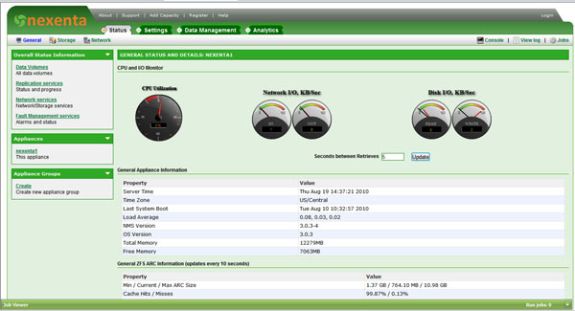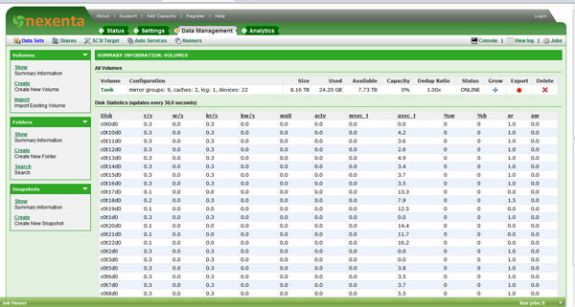ZFS - Building, Testing, and Benchmarking
by Matt Breitbach on October 5, 2010 4:33 PM EST- Posted in
- IT Computing
- Linux
- NAS
- Nexenta
- ZFS
Nexenta
Nexenta is to OpenSolaris what OpenFiler is to Linux or FreeNAS is to FreeBSD. It is a purpose built version of OpenSolaris designed primarily around storage networking including NFS, CIFS, and iSCSI/FC block based storage. Nexenta has taken a lot of time building a great front-end to manage ZFS enabled storage and integrate a plug-in manager that can extend the abilities of a standard x86 platform to rival the best
Nexenta comes in three flavors, Nexenta Core, Nexenta Community, and Nexenta Enterprise. The availability of these three versions allows you to select what kind of product you want, and what kind of expenditures that you will incur.
Nexenta Core is the most basic of the options, but it is also the most forgiving in terms of licensing. Nexenta Core is a command line interface platform only. It is based on an OpenSolaris kernel, and an Ubuntu Userland. There is no limit to the amount of storage that you can configure or use with Nexenta Core, and it is completely free. Nexenta Core can be found here.
Nexenta Community is the next step up. Nexenta Community is based on Nexenta Core, and includes a great GUI interface for managing all aspects of the storage platform. Nexenta Community is also free, but it is limited to 12TB of used storage. Nexenta Community Edition can be found here.
Nexenta Enterprise is the top-level offering. Nexenta Enterprise is a superset of Nexenta Community with many Enterprise level features, including support options. Nexenta Enterprise is licensed based on RAW storage capacity. You can find pricing information here.
Screenshots of web GUI
Nexenta has been very easy to use in our testing. After a few minutes of familiarization with the interface everything is pretty straight forward. You can go from a bare installation to something that has an array configured, an iSCSI target configured, and is ready to take data in a matter of 5-10 minutes. All of the features for sending out notifications and for lighting up indicator lights work as expected and are easy to configure. With just a few menu clicks you're ready to enter all of the information that the system needs to notify you about any problems that it encounters.
Some of the shortcomings that we saw in the Nexenta Enterprise offering were in the reporting and support areas of the product. We did not investigate the reporting problem in depth, as it was not pertinent to the performance data of the system. We would expect that with a little troubleshooting it would be something that would be easily resolved. Throughout the testing process though the daily reports stated that there was no network traffic being generated even though we were loading the interface quite heavily during testing.
This brings us to our next issue that we had with Nexenta, and that was the support channels. We would have gladly troubleshot the issues with reporting if we thought it was going to be done in a timely manner. Since we were using the Enterprise Trial license the support was lackluster at best. We were assured by sales representatives that paid-for support is much faster and much better than the "free trial" support. Free Trial support is treated as their lowest priority support queue. We were not impressed with this as we have always thought of a time-limited free trial period to be pre-sales. If you want to convert someone from a non-paying free trial to a paid product, show them how good the product and support is during that period.












102 Comments
View All Comments
Mattbreitbach - Tuesday, October 5, 2010 - link
Indeed you can, which is one of the most exciting parts about using software based storage appliances. Nexenta really excels in this area, offering iSCSI, NFS, SMB, and WebDAV with simple mouse clicks.MGSsancho - Tuesday, October 5, 2010 - link
or a single command!FransUrbo - Wednesday, January 11, 2012 - link
Would be really nice to see how ZoL compares. It's in no way optimized yet (current work is on getting the core functionality stable - which IMHO it is) so it would have no chanse against OpenSolaris or Nexenta, but hopfully it's comparative to the Promise rack.http://zfsonlinux.org/
gfg - Tuesday, October 5, 2010 - link
NAS is extremely cost effective in a data center if a large majority of NFS/CIFS users are more interested in capacity, not performance. NDMP can be very efficent for backups, and the snapshots/multi-protocol aspects of NAS systems are fairly easy to manage. Some of the larger Vendor NAS systems can support 100+TB's per NAS fairly effectively.bhigh - Wednesday, October 6, 2010 - link
Actually, OpenSolaris and Nexenta can act as a SAN device using COMSTAR. You can attach to them with iSCSI, FC, Infiniband, etc. and use any zvols as raw scsi targets.JGabriel - Wednesday, October 6, 2010 - link
Also, "Testing and Benchmarking"?Doesn't that mean the same thing and isn't it redundant? See what I did there?
.
Fritzr - Thursday, October 7, 2010 - link
This is similar to the NAS<>SAN argument. They are used in a similar manner, but have very different purposes.Testing. You are checking to see if the item performance meets your need & looking for bugs or other problems including documentation and support.
Benchmarking. You are running a series of test sets to measure the performance. Bugs & poor documentation/support may abort some of the measuring tools, but that simply goes into the report of what the benchmarks measured.
Or in short:
Test==does it work?
Benchmark==What does it score on standard performance measures?
lwatcdr - Friday, October 8, 2010 - link
I am no networking expert so please bear with me.What are the benfits of a SAN over local drivers and or a NAS?
I would expect a NAS to have better performance since it would send less data over the wire than a SAN if they both had the same physical connection.
A local drive/array I would expect to be faster than a SAN since it will not need to go through a network.
Does it all come down to management? I can see the benefit of having your servers boot over the network and having all your drives in one system. If you set up the servers to boot over the network it would be really easy to replace a server.
Am I missing something or are the gains all a matter of management?
JohanAnandtech - Sunday, October 10, 2010 - link
A NAS has most of the time worse performance than a similar SAN since there is a file system layer on the storage side. A SAN only manages block and has thus less layers, and is more efficient.A local drive array is faster, but is less scalable and depending on the setup, it is harder to give a large read/write cache: you are limited by the amount of RAM your cache controller supports. In a software SAN you can use block based caches in the RAM of your storage server.
Management advantages over Local drives are huge: for example you can plug a small ESXi/Linux flash drive which only contains the hypervisor/OS, and then boot everything else from a SAN. That means that chances are good that you never have to touch your server during its lifetime and handle all storage and VM needs centrally. Add to that high availability, flexibility to move VMs from one server to another and so on.
lwatcdr - Monday, October 11, 2010 - link
I but that layer must be executed somewhere I thought that decrease in data sent over the physical wire would make up for the extra software cost on the server side.Besides you would still want a NAS even with a SAN for shared data. I am guessing that you could have a NAS served data from the SAN if you needed shared directories.
I also assume that since most SAN are on a separate storage network that the SAN is mainly used to provide storage to servers and than the servers provide data to clients on the lan.
The rest of it seems very logical to me in a large setup. I am guessing that if you have a really high performance data base server that one might use a DAS instead of SAN or dedicate a SAN server just to the database server.
Thanks I am just trying to educate myself on SANs vs NAS vs DAS.
Since I work at a small software development firm our sever setup is much simpler than the average Data center so I don't get to deal this level of hardware often.
However I am thinking that maybe we should build a SAN and storage network just for our rack.